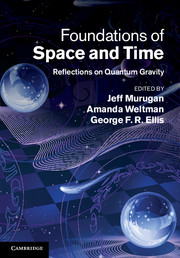Book contents
- Frontmatter
- Contents
- List of contributors
- 1 The problem with quantum gravity
- 2 A dialogue on the nature of gravity
- 3 Effective theories and modifications of gravity
- 4 The small-scale structure of spacetime
- 5 Ultraviolet divergences in supersymmetric theories
- 6 Cosmological quantum billiards
- 7 Progress in RNS string theory and pure spinors
- 8 Recent trends in superstring phenomenology
- 9 Emergent spacetime
- 10 Loop quantum gravity
- 11 Loop quantum gravity and cosmology
- 12 The microscopic dynamics of quantum space as a group field theory
- 13 Causal dynamical triangulations and the quest for quantum gravity
- 14 Proper time is stochastic time in 2D quantum gravity
- 15 Logic is to the quantum as geometry is to gravity
- 16 Causal sets: discreteness without symmetry breaking
- 17 The Big Bang, quantum gravity and black-hole information loss
- 18 Conversations in string theory
- Index
- References
12 - The microscopic dynamics of quantum space as a group field theory
Published online by Cambridge University Press: 05 August 2012
- Frontmatter
- Contents
- List of contributors
- 1 The problem with quantum gravity
- 2 A dialogue on the nature of gravity
- 3 Effective theories and modifications of gravity
- 4 The small-scale structure of spacetime
- 5 Ultraviolet divergences in supersymmetric theories
- 6 Cosmological quantum billiards
- 7 Progress in RNS string theory and pure spinors
- 8 Recent trends in superstring phenomenology
- 9 Emergent spacetime
- 10 Loop quantum gravity
- 11 Loop quantum gravity and cosmology
- 12 The microscopic dynamics of quantum space as a group field theory
- 13 Causal dynamical triangulations and the quest for quantum gravity
- 14 Proper time is stochastic time in 2D quantum gravity
- 15 Logic is to the quantum as geometry is to gravity
- 16 Causal sets: discreteness without symmetry breaking
- 17 The Big Bang, quantum gravity and black-hole information loss
- 18 Conversations in string theory
- Index
- References
Summary
We provide a rather extended introduction to the group field theory approach to quantum gravity, and the main ideas behind it. We present in some detail the GFT quantization of 3D Riemannian gravity, and discuss briefly the current status of the 4-dimensional extensions of this construction. We also briefly report on some recent results, concerning both the mathematical definition of GFT models as bona fide field theories, and avenues towards extracting testable physics from them.
Introduction
The field of non-perturbative and background-independent quantum gravity has progressed considerably over the past few decades [78]. New research directions are being developed, new important developments are taking place in existing approaches, and some of these approaches are converging to one another. As a result, ideas and tools from one become relevant to another, and trigger further progress. The group field theory (GFT) formalism [39, 77, 79] nicely captures this convergence of approaches and ideas. It is a generalization of the much studied matrix models for 2D quantum gravity and string theory [28, 53]. At the same time, it generalizes it, as we are going to explain, by incorporating the insights coming from canonical loop quantum gravity and its covariant spin foam formulation of the dynamics, and so it became an important part of this approach to the quantization of 4D gravity [72, 74, 81, 85]. Furthermore, it is a point of convergence of the same loop quantum gravity approach and of simplicial quantum gravity approaches, like quantum Regge calculus [93] and dynamical triangulations [3, 79], in that the covariant dynamics of the first takes the form, as we are going to see, of simplicial path integrals.
- Type
- Chapter
- Information
- Foundations of Space and TimeReflections on Quantum Gravity, pp. 257 - 320Publisher: Cambridge University PressPrint publication year: 2012
References
- 63
- Cited by



